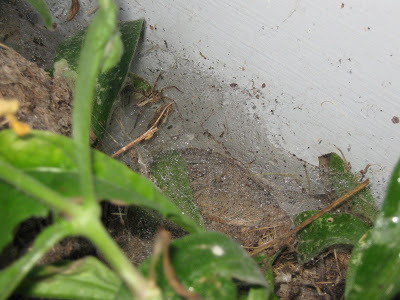Hobo Spiders, Part 1 of 4
 Tobias Mercer/Creative Commons
Tobias Mercer/Creative Commons(The Book of Deadly Animals hits the US later thismonth. As with the recent UK release of the book, I'm going to celebrate byrunning here an expanded version of a story from the book.)
January, 1988. A 56-year-old woman from Spokane feltsomething bite her on the thigh. She came down with a migraine-style headacheand nausea. Her thinking became addled. In the coming days, a patch of deadtissue sloughed from the spot where she'd been bitten. It was perhaps two weeksbefore she sought help, and by then it was too late. She was bleeding from theorifices, even from the ears. Doctors found her blood deficient in severalbasic components. Her marrow had stopped making red blood cells. Havinglingered in the hospital for several weeks, the woman died of internalbleeding.
There were other cases.
November, 1995. In a suburb of Portland, Oregon, aten-year-old boy woke with a pair of bites on his leg. The wounds swelled, grewhot, blistered. Dead tissue dropped away. A week after the bites, his leg wasswollen and red. He suffered fever, nausea, and debilitating headaches. After amonth, the pain of the wounds was mostly gone, but a bruise-like patch of blueremained on his leg. The headaches lasted four months.
October, 1992. A 42-year old woman from Bingham County,Idaho, felt the burning bite of a spider on her ankle. She, too, came down witha headache and nausea, as well as dizziness. The bite blistered and burst,leaving an open wound that continued to grow. After ten weeks the crater wasbig enough to accommodate two thumbs and ringed with black flesh; it was stillgrowing. Eventually, more than two years after the bite, the wound had healedinto a sizable scar, beneath which the veins were clotted. The woman's abilityto walk and stand remained impaired, limiting her job options.
The spider she had found crushed within her clothing was ahobo spider, Tegenaria agrestis, amember of the family Agelinidae.
*
The Agelinidae are hairy, brown or gray, often big enough tostraddle the face of a pocket watch. They build flat webs with a sort ofbilliard pocket at one corner in which the spider lies at her ease to awaitprey. They're common as cliches, found in temperate places all over the world,in about 38 genera and 500 species. In England a type of agelinid, the lesserhouse spider (Tegenaria domestica),is found behind books on the shelf, its thick web tearing when a volume isconsulted. In the American Southwest I've often seen a gray agelinid with longblack stripes. Its abdomen is typically an ovoid tight and ripe as a Septemberplum. This species has eyes that shine like scattered emeralds in the dark, andits webs lie about on the ground cover like silk handkerchiefs—crisply white atfirst, but progressively dirtier with time and use. I have seen these spidersrush out of the funnel when an insect lands on the handkerchief. The spidercloses on its victim like a hirsute hand. It delivers what looks incongruouslylike a kiss to the prey's head, whereupon the prey ceases to struggle withshocking suddenness.
Soon the spider drags his prey into the funnel, where it is hardfor a nosy biped to watch. Usually all I can see are dark masses and anoccasional shadowy scrabbling of legs. What happens, of course, is that thespider injects its digesting venom into the prey, breaking its innards intosoup before sucking them down. The next day I often find a few insect legslittering the edge of the handkerchief.
 Parker Grice
Parker GriceIn the upper Midwest, where the outdoors is coldlyinhospitable to spiders several months a year, I have often noted anotherspecies of agelinid residing in basements. Anything left on the basement floorundisturbed long enough is likely to harbor a mass like a frayed handful ofcotton balls. In one such web I noticed a hummock shaped like a human graveformed over the body of some black creature. This carcass was apparently toomuch trouble to drag over the web's edge. The spider had simply built over it.These northern agelinids are brown and rapid. I've found in their webscreatures as diverse as millipedes and mosquitoes. I touched one web,delicately as I could, and saw the spider heave itself out of its funnel-shapedretreat and immediately collapse back into it, so fast I could hardly have toldwhat it was if I hadn't already known. It reminded me of horror stories told byarachnophobes, about spiders emerging from bathtub drains. I withdrew my fingerwith considerable haste.
The web felt like cloth made of human hair. It didn't stickto me. This is typical of the agelinidae, including the hobo spider—their websaren't gluey, but depend on their deceptive surface to snare insects. Whatseems a solid, smooth place to land is actually a layered network of filaments.Most insects lack the foot-gear to negotiate this snare. Their feet fallbetween the strands, their claws snagging and delaying their escape long enoughfor the spider to seize them. The spider itself walks on the strands byclasping them between claws that oppose each other, much like the opposablethumb-and-finger arrangement of a primate.
The hobo spider shares the web style and habits of thesekinsmen. It is clad in brown herringbone and its body is typically just shortenough to fit on a Lincoln penny. Its genus name means mat-weaver; the speciesname suggests the agrarian lifestyle the species leads in Europe. But in NorthAmerica the hobo spider has taken up an urban lifestyle and made its presenceknown to the human community in ways its European experience never suggested.
Next:Myths and Fears
Published on January 10, 2012 08:30
No comments have been added yet.



